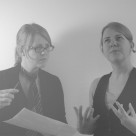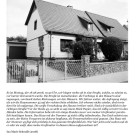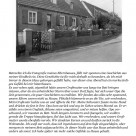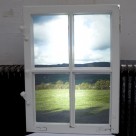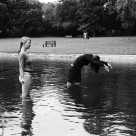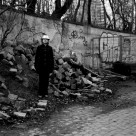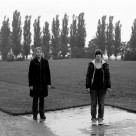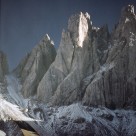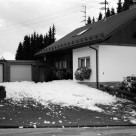A visit to the artist’s studio in November 2009. A conversation about the current thoughts and fascinations of the artist, the concept of truth and homeland in relation to current works. A dialog on family history, community games and the relation it holds to history as well as the visits to former concentration camps.
Recently, at your studio, I found a book with old photographs of the town you were born in. When I opened the book, two folders filled with old family pictures were in there.
Indeed. I have many such photo collections. I find it very exciting to browse around in these. You discover something new every time. When I drive through the town I was born in, I often have these images in my head, and ask myself what it must have looked like a long time ago. In the last month I’ve visited the birthplace of my grandmother. She was born in Poland, in what used to be called Silesia. It was very interesting, my grandmother didn’t stop telling stories all journey. After the second world war, she was deported to West-Germany. It’s very exciting to talk to someone with such historical experiences.
Back to the old pictures you found; They are of areas in Silesia. These are pictures that were taken in front of my grandmothers house of birth. But actually there’s always some old pictures lying around my desk. Often I would like to travel back in time and visit those places. To see if it’s really like the descriptions and pictures in the books. One of my friends told me I should better have been living a century ago. Which is of course nonsense. Would I have lived during the first world war, I’d probably be fascinated by the thirty-year war or something like it. Besides, life was hard. The winters were too cold, and to have to start a seven-child family with my first love seems far from perfect.
Back to the future (‚Zurück in die Zukunft‘), what should I think about that photo-series? Here are the old pictures again.
Back to the future (‚Zurück in die Zukunft‘) is the title of one of my current works. It’s still in the process of being created. It consists of old pictures being juxtaposition-ed with new ones of the same location.
For example, I have taken a picture of my father and his brother, which was taken around 1974, and positioned it next to a picture of them taken in 2008. Between these pictures lie 35 years.
I have collected other old pictures and I will do the same there. Some of the pictures will be accompanied by text. This text will be written by the person who took the picture. How this will evolve, how many I will make, and what it will look like, is still quite unsure though.
It’s hard to tell you much here, maybe next time we meet. The greater idea however is that it takes on themes like change and observation. I can say that much already.
Last year you traveled along the former inner German border between East- and West-Germany. This year you visited former concentration camps from the Nazi-era. You seem to have a fascination for heavy historical themes.
At the start I wasn’t conscious about how many concentration camps there actually are. To see all of the labor camps, transition camps, death camps and concentration camps, I will need quite some more time. It doesn’t matter where in Germany you live, there’s used to be one of these horrible state-machines within 100 kilometers of you. Today most of them are open to the public. Some of them even have thorough exhibitions and documentation available. Very interesting, you should definitely visit one of them once.
What fascinates me most, though, are the places that after the war have again been occupied, usually as apartments or industry complexes. You can find some very absurd images in these places. In Stadtallendorf there’s a apartment complex near an industrial zone where the inhabitants changed the bunkers into living space. When I first saw that I was speechless.
Why German history?
Well, first of all, I’m German myself. It’s logical to start such research at one’s own roots. Originally the concept started at my grandparents. It’s also quite a practical pragmatic decision.
Why do you dig around in history at all? Is the present too boring?
Boring? No, not boring. Everything that happens in history, influences the present. You can’t create contemporary art when you are not informed about art history. Art is always a possible answer to a question posed in history. And, of course, there’s many different answers. Identity is always a theme for me, and always has to do with history. I am without a homeland, and that’s why the question of identity is always current along with viewing into the past. It’s all a cycle. To put it simply: I can’t do it any other way.
What is that construction over there? The old window and the box you built behind it? It’s still wet from painting… Oh, now I’ve got paint on my fingers!
You are very nosy. But I think it’s good you just look around my studio and ask questions. And that you drink my last cup of coffee. There’s too little questions being asked nowadays. Often people just accept things for what they are. They don’t consider or doubt things at all. But there’s so much in this room alone that you can ask questions about. Often I have no clue what I’m doing, and it helps a lot when someone else comes by and asks questions to satisfy his curiosity. Opening nights for exhibitions are a good example of how this is often not done. Everything seems so holy and untouchable, you are utterly discouraged to ask questions. My advice: don’t take yourself too serious.
About that work; It’s a prototype for a light box. The photo here will be built in. It’s a picture of a landscape from the town I was born in. It will be a window that functions as a light box. I’m going to make a smaller version first. When I have found a appropriate exhibition space, and the necessary budget, I would like to build it on a larger scale. 3 meters wide, for instance. The idea is that you can take your homeland with you to all kinds of places. When you place it in front of an empty wall one’s feeling of nostalgic addiction is constantly satisfied. A well-known look out of the window.
So it’s a picture from you „Heimat„-series?
Yes, it is. I’m currently developing an exhibition concept in which my works come together. I will show series of photo’s, objects and installations. The light box is supposed to be the introduction to the exhibition. What’s better for introduction than a cliché image of my homeland.
Tell us something about this concept, what do you want to exhibit?
Well eerrr… I’m not sure yet. There will be a very dark room in which small monitors are mounted on the wall. On these, there will be displayed photographs made with my camera obscura. They will be heads-up, and mirrored. In the middle of the room there will be a large glass sphere. The sphere captures the images, turns it over and sideways, and displays the image correctly to the viewer. I will have to check if this delivers interesting visual results, and if it works as I hope it will.
Then there will be a room with school tables and school benches. I will create several machines; a coin-operated phone for the people that want to call the outside, a modified computer, several display cases with small work. As I’ve said, I’ve just begun. It could very well be that I remove things, change or add them as I go along.
I hope you will find a suitable room for your exhibition. The work is really good, and when you get a budget for this it would be even better.
What I wanted to ask you; Your view on the concept of truth. When I understand you correctly, it’s a returning theme in your work?
I don’t believe you can say something is „good“ or „bad“. You can perhaps formulate such things differently and say: With the information I have, I can conclude this is bad. But then again, it would not change our way of always trying to subordinate things. We, as people, have certain ideas and will keep to those very strictly. The older we get, the more short-sighted we become. These systems of order are put upon us by culture. To culture belongs the place you were raised and the people around us. Our roots, the way we were raised is very important as well. All that is spread through communication with other people. Every person creates opinions to several subjects, but an opinion is not the same as a fact. Seen in this way, there are no facts. Everything came into existence through some kind of conviction.
Science is one of the most serious efforts to gather true impressions. But even in science it will happen that opinions and convictions corrupt a result. When we look at social interactions, it is even harder to define. People in social settings are never rational in their expression. Misunderstandings are often and one of the greatest dangers in social context.
My personal example is language. Because I live together with a partner that speaks another language, I know first-hand how misunderstandings can create absurd problems. Many of my work plays with the concept of truth. Is there a truth? Put like this, it can be seen as a central theme in my work. It started with my series Kindheit. I was still quite helpless in my approach to this theme back then.
In this picture you place yourself and someone else in places that were important in your childhood?
Yes, that’s correct. Places like my elementary school or the swimming pool I used to frequent as a kid. We pose very unrealistically and exaggerated. These surely aren’t real childhood memories that I act out. It is more like playing a game with truth. I used to visit this place, but when and how exactly is quite unclear to me. Because they’re unclear they’re also quickly faked. We think up stuff or add things from other stories which through subjectivity have lost their truth.
One of your series is called Gesellschaftsspiele. You and another person in the picture react on different themes. The titles of the picture are very important here, since they provide essential information to the concept. Without title, the work is almost impossible to understand. What does the work Oorlog mean?
In the work Oorlog you see a kind of battleground. Oorlog is Dutch for ‚war‘. Destruction, pride, fear are typical hallmarks for a war zone. Of course again it’s very clear I imitate a war image. The whole thing is to be understood through irony. These places are very common in cities, and they always remind me of images from wars. In short: You can only be taken seriously if you don’t take yourself too seriously.
Neuengamme is such a title as well. For me it was an abstract term. I had never heard of it before. After a search on the web I found out it used to be a concentration camp located in the north of Germany, close to Hamburg.
I place myself on the grounds of a former concentration camp and take a picture. The photograph itself is unspectacular. By using this title, I apply a certain importance to it that it doesn’t have visually. I could of course also go into my garden, take a picture and call that Neuengamme. The line between truth and lie is very thin indeed. Places received a historical importance, other deserve it but haven’t been considered important. Maybe it is because they were forgotten, or were declared unimportant by an institution. We record truth, but never objectively. There is no such a thing as real truth. It’s a game of borders between lie and truth.
Which brings us back to the concept of truth. I think I know what you mean.
My second question is the explanation of the term Heimat. It comes up often in your work. What does it mean to you?
From an historical perspective, Heimat meant ‚place of birth‘ or the place you lived in. The culture surrounding Heimat was then about the idealization of small-town life. In literature one can find many references to Heimat, for instance in the ‚Exile‘-Literature. The history of the term i s very rich and fascinating. We treat the term very differently as people did a century ago. Whats also is very interesting, the word only exists in German.
For me personally, it is a feeling. Very abstract and difficult to translate into familiar concepts. Heimat is not a place you can visit although it can be connected to a place. When I visit a place that is connected to many memories, it can sometimes be considered to be Heimat. But this is not through the recognition of the place, but because of the memories of it.
Last summer I have started researching my roots. I’ve visited my grandparent’s birth-places. I’ve visited the birth-home of my grandmother, which she hasn’t entered for 50 years. Even her family hasn’t lived there for a very long time. Absurdly, it might well have been the wrong place, since the street-numbering has been changed in the past. I would still have had sweaty palms while viewing this house, I’m sure. Heimat doesn’t have to be absolutely true.
And here we are again at the questionable nature of truth. Heimat is a place which lives through memories. Memories can lie, and actually always do so at least a bit. Heimat can be the place of your roots, or a place in which you feel at home, be it near a person or in a place. Like the term art, Heimat is hard to define and grasp. The question of what it is exactly fascinates me.
Why did you create a photo-series with the name Heimat? How did you conceive this idea?
In the beginning, I was researching cliché-images from the Heimat culture. The work titled Alpen is a good example of this. It refers to German Heimat-movies. Many of these movies are set in a Utopian homeland. The actions are always the same. An idealized community is on the brink of decay, but in the end everything returns to the good old way. There are no losers everybody wins. Isn’t that gorgeous?
My artificial Alps, which have been often used as a symbol of the homeland, are actually a copy of an image. I have searched for a fitting design for this picture for a long time, and then discovered a photo-wallpaper with these mountains on them. So, if you want you can buy this work in the store and decorate you own home with it.
The history of my own Heimat is an important aspect of my new works. Basically, I’m looking for my roots. I do this to better understand my roots, and myself of course. Would I not have left my place of birth, it would never have been such an important theme in my work. I would then probably assume it was normal not to hang out your washing on Sunday.
On first glance you see a Bavarian house and a snowy piece of land. The photograph is titled Polterabend, which tells us it’s about a wedding’s eve party. The snow could perhaps also be foam. There’s no definitive image here. Almost everything in the image is ambivalent. What fascinates me is the possibility of the lie. I love this double meaning. Would I have called the image a snowy landscape, you would look at it very differently. Camera’s are lying machines, or better put, one can use them very well to spread lies.
What kind of themes will we find when we inspect the considerable series?
First you will find the works I’ve described above like Alpen. Then you will find some images of my hometown. I made walks through the area and tried to look at it like an outsider. I found any absurd things. Conservative frames of thought bleed through in these images.
Last year I exhibited part of this photo-series in my hometown. At the opening, when viewing the work Schlafendes Haus (Sleeping House) someone explained to me he would also close off his windows like this when he would be gone for a longer period. Then he became silent and thought about what it must look like to passers-by.
Ina Marie Schmidt, December 2009.
